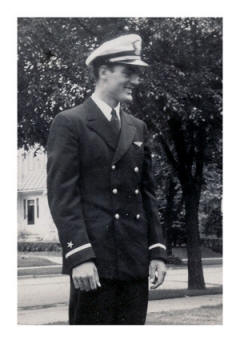 |
|
Ed Scharch wearing Ensign uniform in front yard of
Milwaukee home ca. July 1944. Photo taken around
time of carrier qualification in Chicago. |
Ed's personnel records are incomplete and lack any
mention of the operational flight training he experienced.
Most likely, he was sent to NAS Jacksonville and would have
arrived after completing Intermediate at Pensacola in March
1944.
Records obtained from the National Personnel Records
Center (NPRC) on August 12, 2002, show 379 days unaccounted
for between
dates of Ed's graduation at NAS Pensacola on March 14,
1944, and his eventual discharge from the U.S. Navy on March 28, 1945.
Despite missing records it is possible to sketch out Ed's
experience with operational flight training - based on naval
aviation history, and the personal accounts of many other
Navy pilots as well as Ed's.
According to Hill Goodspeed, historian at the National
Naval Aviation Museum in Pensacola Florida, Ed would have
been sent to the Operation Training Unit (OTU) at Naval Air
Station Jacksonville in Florida. It took about three months
of training in Jacksonville, FL before pilot trainees were
sent to the Carrier Qualification Training Unit at NAS
Glenview, Illinois for the final phase of OT. Aircraft
carrier (CV) pilots were
required to make eight landings and take offs from one of
the two training carriers that operated year round, seven days a
week on Lake Michigan.
Student officers fresh from intermediate training, like NATC
Pensacola's, arrived at Jacksonville and other operational
training activities for the final instruction that prepared
them for the Fleet.
|
Postgraduate School of Naval Aviation
|
|
A back issue of Naval Aviation News, dated September 15, 1944,
described Jacksonville as a "Postgraduate School of Naval
Aviation." The operational training unit is where Naval Aviators, air and ground
crewmen received their final instruction before assignment
to squadrons in which they flew and fought against the
enemy. At the time, Jacksonville's main station covered about 3,200
acres, and outlying activities made up more than three times
as much additional territory.
Major units under the jurisdiction of NAOTC Jacksonville
included Aircraft Delivery Unit, A&R Shop, Supply Depot, all
no "main side"; boat facility and auxiliary air station at
Mayport; Naval Air Gunners' School at Yellow Water; NAAS
Cecil Field; NAAS Green Cove Springs; NAAS Jacksonville
Municipal Airport No. 1, and a number of auxiliary air
facilities and landing areas within a 50-mile radius.
Auxiliary air stations at Cecil Field, Green Cove Springs
and Jacksonville Municipal Airport No. 1 were linked to NAS
and accounted to NAOTC for the operational training of pilots.
In 1939, Navy construction crews began building and
carving NAS Jacksonville out of a semi-tropical wilderness
of pine, oak and palm trees on the long-abandoned site of
the Army's World War I Camp Johnston. The Navy commissioned
the station on October 15, 1940 and pilot training commenced in
January 1941. Naval aviation cadets were instructed in
intermediate training until the establishment of the NAOTC
in April 1942. The last class of cadets finished their
intermediate course in January 1943.
NAS Jacksonville comprised the largest single unit of
NAOTC during WWII. Battle-seasoned instructors conducted the
training of student officers in the techniques of combat
flying and fighting, and also grooming air and ground
crewmen.
Many of the "greats" of naval aviation received their
operational training at NAS Jacksonville. Many of the
outstanding airmen were brought back from combat and gave
Navy and Marine pilots and air crewmen their final training
for the Fleet. They served as instructors at gunnery
schools, technical training centers and operational training
units, where crews of dive bombers, torpedo bombers, scouts,
patrol planes and heavy bombers were welded into combat
teams.
The main supply of pilots was funneled through NAOTC to
the Fleet. The Command turned out naval aviators and
air crewmen in the quantity and quality the Fleet required,
and they were schooled in the tactics and combat maneuvers
demanded by carrier warfare.
Jacksonville and its other subordinate stations handled
all phases of carrier and shore-based operations training.
Fighter pilots underwent instruction at Jacksonville, Green
Cove Springs, Daytona Beach, Melbourne and Sanford, Florida.
Night fighter pilots trained at Vero Beach; dive bombers
pilots at Cecil Field, Miami and DeLand; and torpedo bombers
at Fort Lauderdale and Miami, Florida. Dive bombing and
torpedo bombing practice eventually stopped at
Jacksonville's Switzerland Field OLF when a pilot almost
bombed the east end of the Shands Bridge at Green Cove
Springs by mistake.
Most pilots picked for carrier service took carrier
qualification tests at NAS Glenview after completing
operational syllabus and just before departing for the
Fleet. Multi-engined, multi-place aircraft pilots and crews
trained at other facilities in Florida.
|
Operational Training Syllabus
|
|
Newly commissioned Naval Aviators arrived at
Jacksonville, after completing intermediate flight training,
from stations such as NATC Pensacola. Operational flight training was performed in combat-type aircraft.
Typical CV (carrier fighter) aircraft included Grumman F4F,
or General Motors FM-2 Wildcat; Grumman F6F Hellcat; Vought
F4U, or Goodyear FG Corsair. The CV (carrier fighter) bound
aviator, before assignment to a fleet carrier squadron, was
required to demonstrate their mastery of taking off from and
landing aboard a floating airfield.
All pilots trained
intensively in the use of primary weapons on the ground and
in the air. They were schooled to
meet actual combat situations at Jacksonville. There was no simulation, except
the young pilots and air crewmen aimed at
dummy targets instead of an actual enemy. The .50 caliber fixed
guns fired were the same as those used in actual combat. SBD
and PV type aircraft dropped bombs on moving water targets.
TBF's and TBM's made torpedo drops on target vessels.
Pilots were trained in tactics of combat. Navigation,
communications, how to report enemy positions and respond to
orders from fighter directors were greatly emphasized in
training. Understanding weather, how to avoid its perils and
use it to tactical advantage, along with night flying were
also covered. Pilots were expected to learn to fly
instinctively, to do the right thing at the right time
without conscious thought or effort. This was the transition
stage during which student officers become combat pilots.
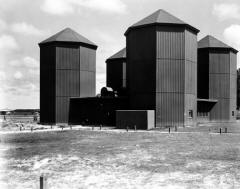 |
|
The building for the Link Celestial Navigation
Trainer housed four simulators at Jacksonville. |
Fighter pilots practiced single-plane combat with the Gun
Air instructor which drills in maneuvering correctly and
aiming accurately. The Link Celestial Navigation Trainer
enabled learners to navigate by the stars without leaving the
ground; Link Instrument Trainer continued the instrument
training that cadets underwent in intermediate flight
training.
Ground school was anything but academic in operational
training. Student officers focused only on subjects that had
direct bearing on their operations with the Fleet. They
continued to study navigation so they could locate a target,
regardless of weather conditions, and find their mobile
airports after shoving off for duty in combat zones. They
went deeper into recognition training of friendly ships and
aircraft verses enemy ones.
Student officers practiced communications using equipment
employed in the Fleet and simulate its use in combat.
Communications practice dealt with correct procedure for
sending a contact report and used fighter director's code in
reports, and for practice use in conversation.
|
Field Carrier Landing Practice (FCLP)
|
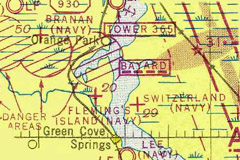 |
|
Aeronautical chart showing OLFs Branan, Fleming's,
Green Cove Springs, and Switzerland fields where
FCLP too place in mid-1940s. |
|
|
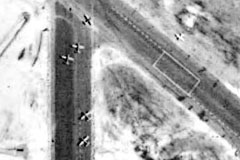 |
|
Jacksonville's nearby NAAS Fleming Island Field in
1943, with aircraft lined up for practice. Pilots
had to land their planes inside the rectangle. |
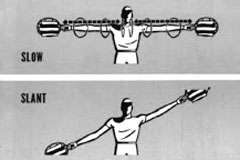 |
|
Landing Signal Officers (LSO) were positioned on the
port-aft corner of the aircraft carrier. |
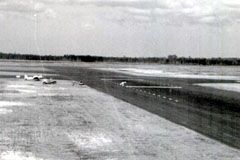 |
|
Lee Field, NAAS Green Cove Springs, on 4/3/1944, is
another satellite of NAS Jacksonville where CV pilots
practiced carrier approaches on land before
qualifying on a "floating airfield." The rectangular markings on
runway represent the deck of an aircraft carrier.
Photo taken shows a LSO using paddles to guide
pilots who must land perfectly within the
rectangular box. |
|
|
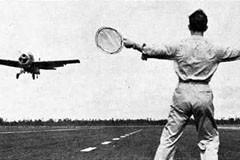 |
|
Operational Training and Field Carrier
Landing Practice at NAAS Green Cove Springs. |
|
|
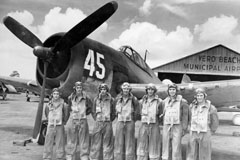 |
|
Good example of Naval Aviators during Operational
Training with Grumman F6F Hellcat fighter in 1944 - albeit a
different base at NAS Vero Beach, FL. Condition of
plane is rough as many were relegated from combat to
OT for pilot trainees to experience FCLP in front
line aircraft. |
Before pilots can actually land aboard aircraft carriers,
they have to practice on a shore-based airfield. Field carrier landing practices are a series of
touch-and-goes (on land) which are observed by a landing signal
officer (LSO) who grades and critiques each landing. The hard-surface runways were painted to resemble the deck of an
aircraft carrier. Trainee pilots were judged on their
ability to plop the aircraft down at the proper spot to
catch the carrier’s arresting wires.
The Navy taught "full stall" landings, as opposed to
guiding the plane to a gentle, smooth landing. The goal for
the fledgling carrier pilot was to have the aircraft run out
of lift just above the flight deck at the right spot, cut
power and "crunch" solidly onto the deck. This
landing technique can be described as a kind of
controlled crash.
After a few months of operational flight training, FCLP was the last
installment of training at NAS Jacksonville. Those who succeeded were sent
to the Carrier Qualification Training Unit at NAS Glenview,
Illinois. CQ was the final stage of all operational flight
training for Navy pilots before combat service.
It is likely that Ed Scharch practiced carrier approaches on
land with the F4U Corsair, or the F6F Hellcat, at one of the
nearby airfields such as NAAS
Green Cove Springs (Lee Field), or its outlying landing
fields at NOLF Branan Field, NOLF Fleming's Field, or NOLF
Switzerland Field. These remote airfields were all part
of the greater NAS Jacksonville complex and set up to provide Field Carrier Landing Practice.
The runways had rectangular markings (about 100 ft long)
representing the landing area on the ramp of an aircraft
carrier where the arresting wires were positioned to trap
the plane.
Following this Field Carrier Landing Practice training the students were sent to
a Carrier Qualification Training Unit at NAS Glenview,
Illinois. Using the available training carriers, USS
Wolverine and the USS Sable, qualifying took place in the
submarine-free waters of Lake Michigan. The prospective
carrier pilot performed the required number of take offs and
landings (eight) to be certified as carrier qualified.
Pilots were then assigned to operational squadrons.
Commissioned as NAAS Green Cove Springs in
February 1943, the auxiliary continued to be known as Lee Field.
Aircraft checkout and carrier qualifications using F4F
Wildcats and F4U Corsairs began in May 1943. Outlying fields
used were at St. Augustine, Switzerland, and Fleming Island
with gunnery flights operated from Palatka. The station
complement numbered over 2,000 officers and men in March
1944.
In early 1945, a newly commissioned (USMC) 2nd Lt.
Ed McMahon arrived at Lee Field,
Green Cove Springs, FL to learn how to fly the F4U Corsair
for operational training and learned FCLP. McMahon later
became famous for his work on television as a pitchman
and sidekick on The Tonight Show Starring Johnny
Carson.
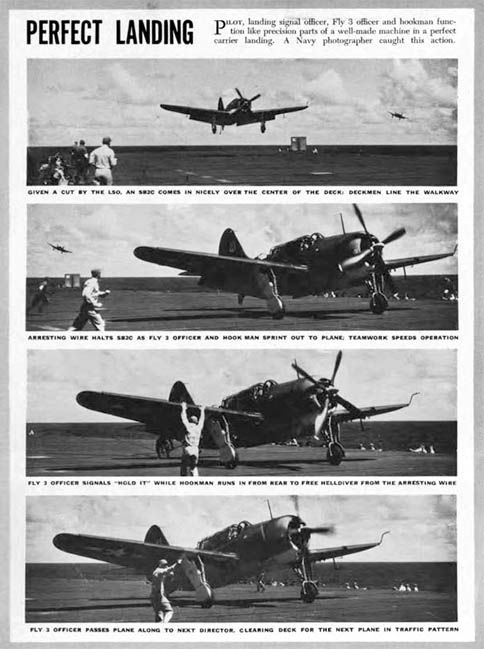
|
|
|
|
NAS Jacksonville History
|
|
Naval Air Station Jacksonville was
officially commissioned on October 15, 1940, and it became the first part of the
Naval Air Operational Training Command complex, that included NAAS Cecil
Field and Naval Station Mayport. Captain Charles P. Mason
raised his pennant as the station's first commanding
officer.
|
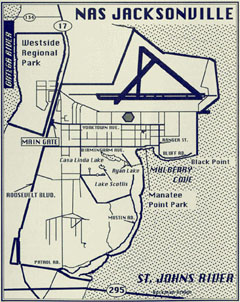 |
|
General map of NSA Jacksonville, Florida |
|
|
Prior to the commissioning, on Sept. 7, 1941 Cmdr. Jimmy
Grant became the first pilot to land on the still unfinished
runway in his N3N-3 biplane. More than 10,000 pilots and
11,000 air crewmen followed their lead to earn the wings of
gold at the station during World War II.
Increased training and construction characterized
Jacksonville’s response to America’s entry into World War
II. Three runways over 6,000 feet long were operating, as
were seaplane ramps. Overhaul and Repair facilities were
built to rework the station's planes. More than 700 buildings sprung to life on the base before
V-J (Victory over Japan) Day, including an 80-acre hospital
and a prisoner-of-war compound which housed more than 1,500
German prisoners of war. Archbishop (later Cardinal) Francis
J. Spellman dedicated St. Edward's Catholic Chapel at its
Birmingham Avenue location on Jan. 17, 1943. The chapel and
other buildings constructed during the war years, intended
for a life of only 20 years, are still in use.
By October 1, 1944, some 6,338 operational
training students had been received with 4,798
graduating. Operational training was not without its
dangerous side, as there were 58 fatalities recorded
in the first 29 months of operation.
|
|
|
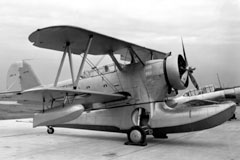 |
|
The first aircraft assigned to NAS
Jacksonville was this Grumman J2F-3
Duck (BuNo 1578), which arrived on 16 January 1940.
This aircraft would remain as the Commanding
Officer's plane. |
|
|
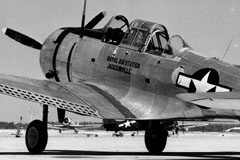 |
|
Douglass SBD-5 Dauntless scout/dive bomber with
distinctive perforated split flaps or "dive-brakes"
was another carrier-borne combat plane used for
operational training at NAOTC Jacksonville. |
|
|
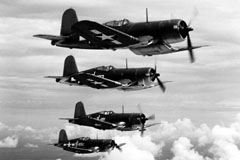 |
|
Vought
F4U-1 Corsair fighters over NAS
Jacksonville, Florida in 1944 used for operational
flight training, also served as a combat fighter. |
|
Timeline NAS Jacksonville
|
| Jan. 16, 1940 |
First aircraft assigned to station, a
Grumman J2F-3, arrives in NAS Jacksonville. |
| Oct. 15, 1940 |
NAS Jacksonville commissioned at high noon. Capt.
Charles Perry Mason first commanding officer. Training
Squadron VN-13, D-7 established. Admiral John Towers in
attendance. |
| Dec. 24, 1940 |
Station’s first training
aircraft arrive as 10 N2S Stearmans fly in direct from the
factory in St. Louis. |
| Jan. 2, 1941 |
First primary
training squadron, VN-11, commissioned. |
| March 5, 1941 |
Seaplane squadrons VN-14 and VN-15 established, using
nine P2Ys and P2Y-3s aircraft. |
| June 24, 1941 |
First
class of aviation cadets receives their wings (Ensigns
Hemphill, Kennedy and Shortlidge). |
| Aug. 15, 1941 |
First major aircraft overhaul completed at the Assembly and
Repair (A&R) shops with completion of N2S Stearman No. 3423. |
| Sept. 20, 1941 |
Officers' Club dedicated. |
| May 1, 1942 |
Rear Adm. A.B. Cook became the Chief of Naval Air
Operational Training Command with headquarters at NAS
Jacksonville. |
| May 24, 1942 |
Station flies 254
aircraft at one time as a demonstration of air power for
visiting Pan-American officials. |
| Aug. 28, 1942 |
Aviation Free Gunnery School commissioned near Cecil Field. |
| Oct. 15, 1942 |
Operational Training began with PBY sea
planes as VPB2 (Patrol Bomber) OTU (Outgoing Training Unit)
No. 1 is established and training squadron VN-15
disestablished. First aircraft turrets arrive (.30 and .50
caliber) at Gunners School. |
| Feb. 20, 1943 |
Training
Squadron VN-14 became Observation Squadron VO-VCS and began
operational training with OS2U Kingfisher aircraft which
included catapult practice. |
| April 1943 |
Lt. Cmdr.
Charles Henri de Levis Mirepoix succeeded Lieutenant Andre
Gilbert as Commanding Officer of the Fighting French Naval
Aviation Unit at NAS Jacksonville. |
| Oct. 26, 1943 |
VF
(fighter aircraft) training begins in the F4U Corsair. |
| March 10, 1944 |
Two SNB twin-engine aircraft assigned
and the multi-engine phase of instruction inaugurated. |
| July 18, 1944 |
First arrested landing on airfield. |
| Sept. 10, 1944 |
NAS Jacksonville pilots achieved more
than 1-million hours of flying time. |
| Nov. 28, 1944 |
First helicopter lands at station (Sikorsky HNS). |
| Dec. 22, 1944 |
MF-OTU, first all-Marine Fighter Squadron
aboard NAS Jacksonville established. |
| Aug. 31, 1945 |
Navy Separation Center Commissioning Ceremony held.
Thousands of Sailors would be discharged from the Navy
before the center was closed. |
|
|
|
Naval Air Station Insignias by Disney
|
|
Artists from Disney Studios created at least seven different insignia
designs for units that were either stationed, or received
training at Naval Air Station Jacksonville, Florida. Six of
those designs were created during World War II. Here are
three. The station's first design featured a flying squirrel.
The station's second design featured Donald Duck in a split
airborne eggshell, which represented the station's role at
war's outset - that of a primary training school.
|
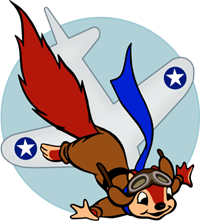 |
|
First station insignia "Flying Squirrel"
was created by
Disney artist Roy Williams and used by NAS
Jacksonville 1940-1941, for their Primary flight
training program. |
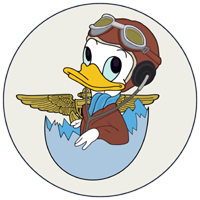 |
|
Second station
insignia was first to feature Donald Duck in "split
airborne eggshell." New Disney design replaced
station's flying
squirrel mascot in March 1941, for their Primary flight
school. |
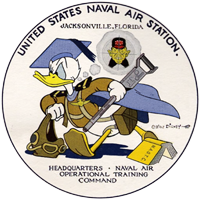 |
|
Third Disney-designed insignia adopted when NAS
Jacksonville was redesignated
Headquarters of Naval Air Operational Training
Command in June 1943. |
|
|
|
|
|
The stations third design was created in June 1943 as a
replacement for the Donald in the eggshell design. A story
in the July 22, 1943 issue of the base's newsletter "JAX Air
News," read in part:
"Donald Duck, the Station's mascot on the old
insignia used in the days when aviation cadets trained here,
is still the mascot on the new emblem, but he's a changed
man.
Donald...is a belligerent chap with a grim-visage and
a bellicose glint in his eye that bodes no good for the
Axis. Machine gun in hand, cloaked in the cap and gown of a
graduate flier with ensign's stripe on his shoulder boards
and a vision of Hirohito in his gun-sight, Donald will make
his debut on the Station soon.
The revamped Station insignia...illustrates the
change of activity here...as Headquarters for Naval and
Marine commissioned officers operational training, the
station now sports the fastest and deadliest Navy planes and
most skilled instructors in the world.
Many of the earlier cadets who first sprouted wings
here have won their spurs in action on the world’s battle
map. Vice-Admiral Aubrey W. Fitch, Commander Aircraft, South
Pacific, recently cabled as follows: 'Operational trained
Navy and Marine Corps pilots arriving this area are
demonstrating a high order of ability as combat pilots.'"
|
|
A 52-page booklet was published for base civilian
employees in 1945. This design also appears on several
different matchbooks and stationary. As an interesting side note, the illustrations found
inside the JAX booklet were originally created for a 1943
Disney new employees booklet called, "the Ropes at Disney's.
|
|
|